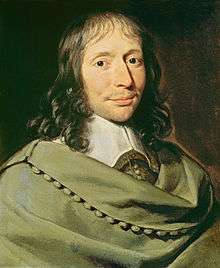Bible de Port-Royal

The Bible de Port-Royal (or Bible de Sacy) is a French translation of the Catholic Bible, which was first published in installments between 1667 and 1696. Though praised for the purity of its classical form, the work attracted the suspicion of the Jesuits, who discovered in it a latent Protestantism, and was criticized by Richard Simon, a former Oratorian, on text-critical grounds. For over three centuries it has been among the most popular of French Bible translations.[1]:349
History
Several Solitaires of Port-Royal,[nb 1] an early Jansenist monastery, had met to consider the viability of a New Testament translation from 1657 to 1660. One of them, Antoine Le Maistre, began the task of translation in 1657, and his brother, Louis-Isaac Lemaistre de Sacy, continued the work after the former's death in 1658. The Nouveau Testament de Mons (or Version de Mons), their translation of the New Testament, was published in 1667 by Daniel Elzevier. The Old Testament appeared in several parts between 1672 and 1696.[2]:329-330
In 1688, Antoine Arnauld published a defence of the translation project against charges of latent Protestantism, the Défense des versions de langue vulgaire de l’Écriture Sainte, in which he argued that, just as the Vulgate had been a translation of the Scriptures into the vernacular of the day, so a translation into French, which had undergone significant reforms at the end of the sixteenth century, was necessary to ensure the intelligibility of the Bible to the common man.[2]:329
The translation was a "masterpiece of French literary classicism",[3]:767 but was censured by Jacques-Bénigne Bossuet for its "politeness". The Jansenist Martin de Barcos objected that the translators had demystified the Scriptures.[1]:349 Richard Simon, a textual critic and former Oratorian, complained that the work was more interpretative paraphrase than translation, and noted with disapproval the use of the Vulgate, "avec les différences du Grec" (with corrections from the original Greek),[4]:200 as the basis of the Nouveau Testament.[2]:332–333 Nonetheless, the translation was an immediate success. The philosopher Blaise Pascal, who had seen an early draft of the translation, quoted from the Nouveau Testament in his Pensées.[1]:349
Notes
- ↑ Antoine Arnauld, Pierre Nicole, Claude Lancelot, Antoine Le Maistre, and Louis-Isaac Lemaistre de Sacy.[2]:329
References
- 1 2 3 S. L. Greenslade (31 October 1975). The Cambridge History of the Bible: Volume 3, The West from the Reformation to the Present Day. Cambridge University Press. ISBN 978-0-521-29016-6. Retrieved 12 January 2013.
- 1 2 3 4 Rens Bod; Jaap Maat; Thijs Weststeijn (1 January 2010). The Making of the Humanities: Early Modern Europe. Amsterdam University Press. ISBN 978-90-8964-269-1. Retrieved 12 January 2013.
- ↑ Bruce M. Metzger; Michael David Coogan (11 September 1993). The Oxford Companion to the Bible. Oxford University Press. ISBN 978-0-19-504645-8. Retrieved 12 January 2013.
- ↑ John McManners (1999). Church and Society in 18th Century France: The Religion of the People and the Politics of Religion. Oxford University Press. ISBN 978-0-19-827004-1. Retrieved 12 January 2013.
Further reading
- Antoine Arnauld; Lamoignon; Séminaire Saint-Irénée (1688). Défense des versions de l'Ecriture sainte, des Offices de l'Eglise et des ouvrages des Pères, et en particulier de la nouvelle traduction du Bréviaire romain (in French). N. Schouten. Retrieved 12 January 2013.
- Lemaistre de Sacy, Isaac (1667). Nouveau Testament de Mons (in French). Bibliothèque nationale de France. Retrieved 12 January 2013.